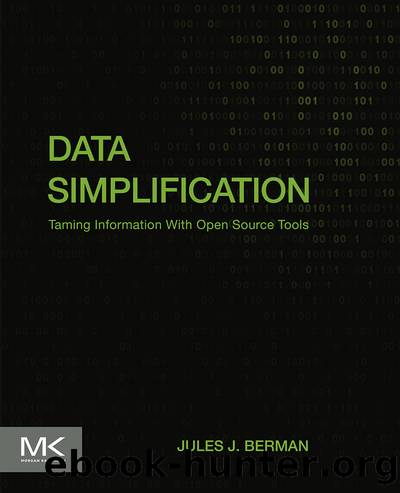Data Simplification by Berman Jules J.;

Author:Berman, Jules J.; [Berman, Jules J.]
Language: eng
Format: epub
Publisher: Elsevier Science & Technology
Published: 2016-03-14T00:00:00+00:00
In spreadsheets, the data elements are the cells of the spreadsheet. The column headers are the metadata that describe the data values in the column's cells, and the row headers are the record numbers that uniquely identify each record (ie, each row of cells). See XML.
Microarray Also known as gene chip, gene expression array, DNA microarray, or DNA chips. These consist of thousands of small samples of chosen DNA sequences arrayed onto a block of support material (such as a glass slide). When the array is incubated with a mixture of DNA sequences prepared from cell samples, hybridization will occur between molecules on the array and single stranded complementary (ie, identically sequenced) molecules present in the cell sample. The greater the concentration of complementary molecules in the cell sample, the greater the number of fluorescently tagged hybridized molecules in the array. A specialized instrument prepares an image of the array, and quantifies the fluorescence in each array spot. Spots with high fluorescence indicate relatively large quantities of DNA in the cell sample that match the specific sequence of DNA in the array spot. The data comprising all the fluorescent intensity measurements for every spot in the array produces a gene profile characteristic of the cell sample.
Missing values Most complex data sets have missing data values. Somewhere along the line, data elements were not entered, or records were lost, or some systemic error produced empty data fields. Various mathematical approaches to missing data have been developed; commonly involving assigning values on a statistical basis (ie, assignment by imputation). Imputation methods are based on the assumption that missing data arises at random. When missing data arises nonrandomly, there is no satisfactory statistical fix. The data curator must track down the source of the errors, and somehow rectify the situation. In either case, the issue of missing data introduces a potential bias, and it is crucial to fully document the method by which missing data is handled. See Data cleaning.
Monte Carlo simulation Monte Carlo simulations were introduced in 1946 by John von Neumann, Stan Ulam, and Nick Metropolis.43 For this technique, the computer generates random numbers and uses the resultant values to simulate repeated trials of a probabilistic event. Monte Carlo simulations can easily simulate various processes (eg, Markov models and Poisson processes) and can be used to solve a wide range of problems, discussed in detail in Section 8.2. The Achilles heel of the Monte Carlo simulation, when applied to enormous sets of data, is that so-called random number generators may introduce periodic (nonrandom) repeats over large stretches of data.44 What you thought was a fine Monte Carlo simulation, based on small data test cases, may produce misleading results for large data sets. The wise data analyst will avail himself of the best possible random number generator, and will test his outputs for randomness (See Open Source Tools for Chapter 5, Pseudorandom number generators). Various tests of randomness are available.45,46
Multiple comparisons bias When you compare a control group against a treated group
Download
This site does not store any files on its server. We only index and link to content provided by other sites. Please contact the content providers to delete copyright contents if any and email us, we'll remove relevant links or contents immediately.
Exploring Deepfakes by Bryan Lyon and Matt Tora(7782)
Robo-Advisor with Python by Aki Ranin(7676)
Offensive Shellcode from Scratch by Rishalin Pillay(6131)
Microsoft 365 and SharePoint Online Cookbook by Gaurav Mahajan Sudeep Ghatak Nate Chamberlain Scott Brewster(5075)
Ego Is the Enemy by Ryan Holiday(4968)
Management Strategies for the Cloud Revolution: How Cloud Computing Is Transforming Business and Why You Can't Afford to Be Left Behind by Charles Babcock(4444)
Python for ArcGIS Pro by Silas Toms Bill Parker(4205)
Elevating React Web Development with Gatsby by Samuel Larsen-Disney(3912)
Machine Learning at Scale with H2O by Gregory Keys | David Whiting(3664)
Learning C# by Developing Games with Unity 2021 by Harrison Ferrone(3287)
Speed Up Your Python with Rust by Maxwell Flitton(3235)
Liar's Poker by Michael Lewis(3232)
OPNsense Beginner to Professional by Julio Cesar Bueno de Camargo(3197)
Extreme DAX by Michiel Rozema & Henk Vlootman(3176)
Agile Security Operations by Hinne Hettema(3125)
Linux Command Line and Shell Scripting Techniques by Vedran Dakic and Jasmin Redzepagic(3113)
Essential Cryptography for JavaScript Developers by Alessandro Segala(3084)
Cryptography Algorithms by Massimo Bertaccini(3003)
AI-Powered Commerce by Andy Pandharikar & Frederik Bussler(2989)
